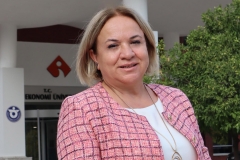
VOCATIONAL SCHOOL OF HEALTH SERVICES
Department of Paramedic
IAY 210 | Course Introduction and Application Information
| Course Name |
Emergency Medicine Applications
|
|
Code
|
Semester
|
Theory
(hour/week) |
Application/Lab
(hour/week) |
Local Credits
|
ECTS
|
|
IAY 210
|
Fall/Spring
|
2
|
0
|
2
|
3
|
| Prerequisites |
None
|
|||||
| Course Language |
Turkish
|
|||||
| Course Type |
Elective
|
|||||
| Course Level |
Short Cycle
|
|||||
| Mode of Delivery | - | |||||
| Teaching Methods and Techniques of the Course | - | |||||
| Course Coordinator | ||||||
| Course Lecturer(s) | ||||||
| Assistant(s) | - | |||||
| Course Objectives | End of the lesson ,the students will be able to apply to drugs in ambulance and prehospital |
| Learning Outcomes |
The students who succeeded in this course;
|
| Course Description | General drug knowledge,the mechanisms of action of drugs on the autonomic nervous system, the routes of applications of drugs and the principles, emergency ,medical personnel’s scope of practice and laws according the practice, medication administrations during acute coronary syndrome, drugs administration during intoxication, drug administration during respiratory issues, emergency drugs used during cognition and psychological illnesses, Drugs administered during CPR, drugs used on anaphylaxis and allergies, medications used during the bleeding and pregnancy, drugs used during the pediastric emergencies. |
|
|
Core Courses | |
| Major Area Courses | ||
| Supportive Courses |
X
|
|
| Media and Management Skills Courses | ||
| Transferable Skill Courses |
WEEKLY SUBJECTS AND RELATED PREPARATION STUDIES
| Week | Subjects | Related Preparation |
| 1 | Acknowledgment of the beginning of class basic drug knowledge, classification of effects of drugs. | Patient Treatment Protocols, 2016,135-137 |
| 2 | During the medication application, emergency medical personnel’s scope of practice lawful responsibilities. | Patient Treatment Protocols, 2016,135-137 |
| 3 | Principles of emergency medications administrations, the most proper routes, calculations of drug dosages and drugs effects autonomic nervous system | Patient Treatment Protocols, 2016,135-137 |
| 4 | Emergency medication administration during acute coronary syndrome.The drugs used, effective mechanism, therapeutic usage, indications of pre-hospital usage, contraindications, points to pay attention, dosage and routes, precautions and adverse reactions, where to pay attention for paramedics, drugs’ potentiation. | Patient Treatment Protocols, 2016,141,147,148,161,165,167 |
| 5 | Drug administration during respiratory distress.The drugs used, effective mechanism, therapeutic usage, indications of pre-hospital usage, contraindications, points to pay attention, dosage and routes, precautions and adverse reactions, where to pay attention for paramedics, drugs’ potentiation. | Patient Treatment Protocols, 2016, 139,149,157,161,162 |
| 6 | Drug administration during intoxications The drugs used, effective mechanism, therapeutic usage, indications of pre-hospital usage, contraindications, points to pay attention, dosage and routes, precautions and adverse reactions, where to pay attention for paramedics, drugs’ potentiation. | Patient Treatment Protocols, 2016, 156, |
| 7 | Drugs to be administered for patients who are unconscious.The drugs used, effective mechanism, therapeutic usage, indications of pre-hospital usage, contraindications, points to pay attention, dosage and routes, precautions and adverse reactions, where to pay attention for paramedics, drugs’ potentiation. | Patient Treatment Protocols, 2016,141,147,148,161,165,167 |
| 8 | ARA SINAV | ARA SINAV |
| 9 | Emergency psychiatric and deprivation drug administration. The drugs used, effective mechanism, therapeutic usage, indications of pre-hospital usage, contraindications, points to pay attention, dosage and routes, precautions and adverse reactions, where to pay attention for paramedics, drugs’ potentiation. | Patient Treatment Protocols, 2016,141,147,148,161,165,167 |
| 10 | Drugs used for anaphylactic shock and allergic reactions.The drugs used, effective mechanism, therapeutic usage, indications of pre-hospital usage, contraindications, points to pay attention, dosage and routes, precautions and adverse reactions, where to pay attention for paramedics, drugs’ potentiation. | Patient Treatment Protocols, 2016, 139,149,157,161,162 |
| 11 | Drugs used during the cardiopulmonary resuscitation. The drugs used, effective mechanism, therapeutic usage, indications of pre-hospital usage, contraindications, points to pay attention, dosage and routes, precautions and adverse reactions, where to pay attention for paramedics, drugs’ potentiation. | Patient Treatment Protocols, 2016,141,147,148,161,165,167 |
| 12 | Drugs used during the pediatric emergencies.The drugs used, effective mechanism, therapeutic usage, indications of pre-hospital usage, contraindications, points to pay attention, dosage and routes, precautions and adverse reactions, where to pay attention for paramedics, drugs’ potentiation. | Patient Treatment Protocols, 2016,141,147,148,161,165,167 |
| 13 | Drugs used during the emergency birth.The drugs used, effective mechanism, therapeutic usage, indications of pre-hospital usage, contraindications, points to pay attention, dosage and routes, precautions and adverse reactions, where to pay attention for paramedics, drugs’ potentiation. | Hastane öncesi Acil Hasta Bakımı cilt-I-II Editör. Yrd.Doç.Dr. Ali EKŞİ. Ana yayını. İzmir, 2015,99-103 |
| 14 | Emergency drugs cards. | Paramedik İlaç kartları ,Ali Ekşi,Kitapana basım yayın dağıtım bilişim 1-50 |
| 15 | Review Period | Paramedik İlaç kartları ,Ali Ekşi,Kitapana basım yayın dağıtım bilişim 1-50 |
| 16 | FİNAL SINAVI | FİNAL SINAVI |
| Course Notes/Textbooks | Hastane öncesi Acil Hasta Bakımı cilt-I-II Editör. Yrd.Doç.Dr. Ali EKŞİ. Ana yayını. İzmir, 2015 |
| Suggested Readings/Materials |
EVALUATION SYSTEM
| Semester Activities | Number | Weigthing |
| Participation |
1
|
5
|
| Laboratory / Application | ||
| Field Work | ||
| Quizzes / Studio Critiques | ||
| Portfolio | ||
| Homework / Assignments | ||
| Presentation / Jury |
1
|
25
|
| Project | ||
| Seminar / Workshop | ||
| Oral Exams | ||
| Midterm |
1
|
35
|
| Final Exam |
1
|
35
|
| Total |
| Weighting of Semester Activities on the Final Grade |
3
|
65
|
| Weighting of End-of-Semester Activities on the Final Grade |
1
|
35
|
| Total |
ECTS / WORKLOAD TABLE
| Semester Activities | Number | Duration (Hours) | Workload |
|---|---|---|---|
| Theoretical Course Hours (Including exam week: 16 x total hours) |
16
|
2
|
32
|
| Laboratory / Application Hours (Including exam week: '.16.' x total hours) |
16
|
0
|
|
| Study Hours Out of Class |
14
|
2
|
28
|
| Field Work |
0
|
||
| Quizzes / Studio Critiques |
0
|
||
| Portfolio |
0
|
||
| Homework / Assignments |
0
|
||
| Presentation / Jury |
1
|
20
|
20
|
| Project |
0
|
||
| Seminar / Workshop |
0
|
||
| Oral Exam |
0
|
||
| Midterms |
1
|
10
|
10
|
| Final Exam |
1
|
10
|
10
|
| Total |
100
|
COURSE LEARNING OUTCOMES AND PROGRAM QUALIFICATIONS RELATIONSHIP
|
#
|
Program Competencies/Outcomes |
* Contribution Level
|
||||
|
1
|
2
|
3
|
4
|
5
|
||
| 1 | To have the required contemporary theoretical and practical knowledge in his/her field |
X | ||||
| 2 | To use the material and technology related to his/her field, and make their maintenance, use the information and communication technologies at basic level |
|||||
| 3 | To have the competency to recognize the problems in his/her field, analyze them, develop evidence-based solutions and have the ability to share their suggestions with others |
|||||
| 4 | To be aware of legal responsibilities, conduct basic studies in her/his field independently |
|||||
| 5 | To communicate with patients, relatives and colleagues properly, comprehensively, honestly and explicitly, transfer his/her thoughts and knowledge through written and oral communication |
|||||
| 6 | To take responsibility as an active team member during the practices in his/her field |
|||||
| 7 | To commentate and evaluate the scientific information with a critical approach by the help of knowledge gained in his/her field |
|||||
| 8 | To comprehend the importance of lifelong learning, to determine and meet her/his learning needs, to develop herself/himself by monitoring the development in science and technology |
X | ||||
| 9 | To act by considering the universal ethical values, social and cultural characteristics |
|||||
| 10 | To know the concepts of occupational safety, patient safety, environmental protection and quality, and fulfill the requirements |
|||||
| 11 | To be able to follow information in his field and communicate with colleagues in English at least a level of European Language Portfolio A2 General Level |
|||||
| 12 | To take responsibility at crisis situations and hazards |
|||||
| 13 | To determine the needs according to the requirements, carry out activities for development in the field of emergency care |
|||||
*1 Lowest, 2 Low, 3 Average, 4 High, 5 Highest
NEWS |ALL NEWS

Earthquake Safety Tips
In the video footage that emerged after the 6.6-magnitude earthquake in Izmir, it was seen that most citizens did not know what

Don't buy every mask you see on the street
Nursun Üstünkarlı, Lecturer at Paramedic Program, Izmir University of Economics (IUE), warned citizens that masks, which are vital in the fight against
